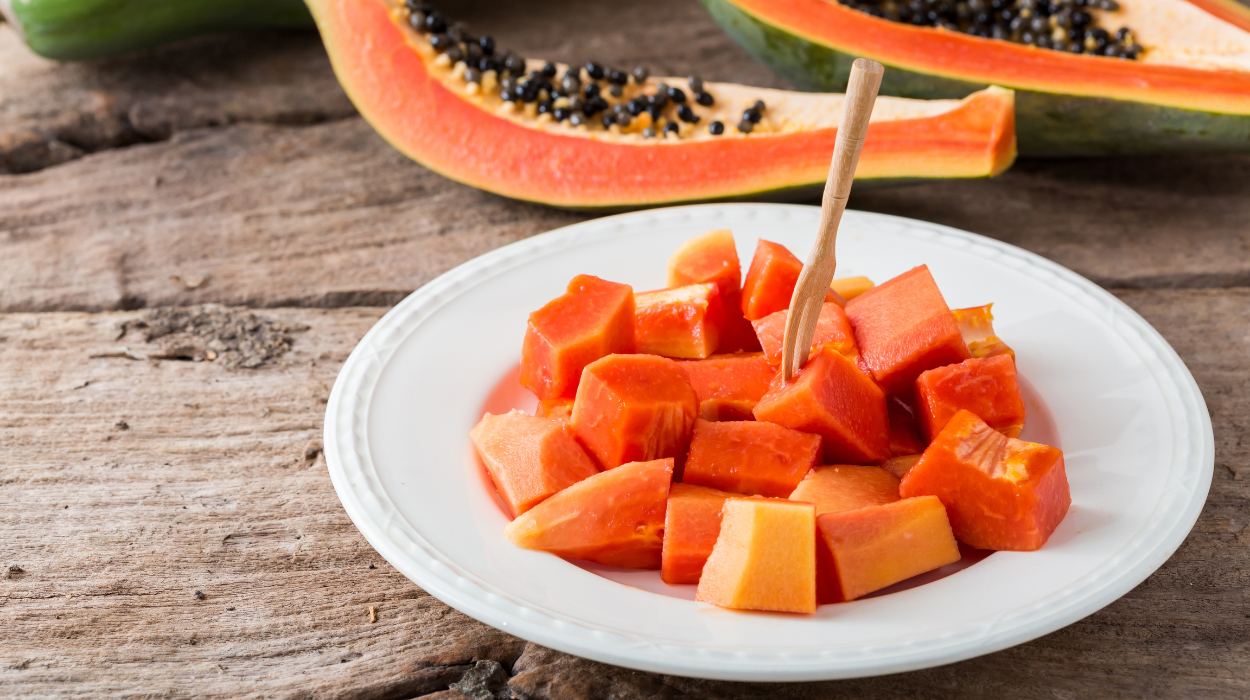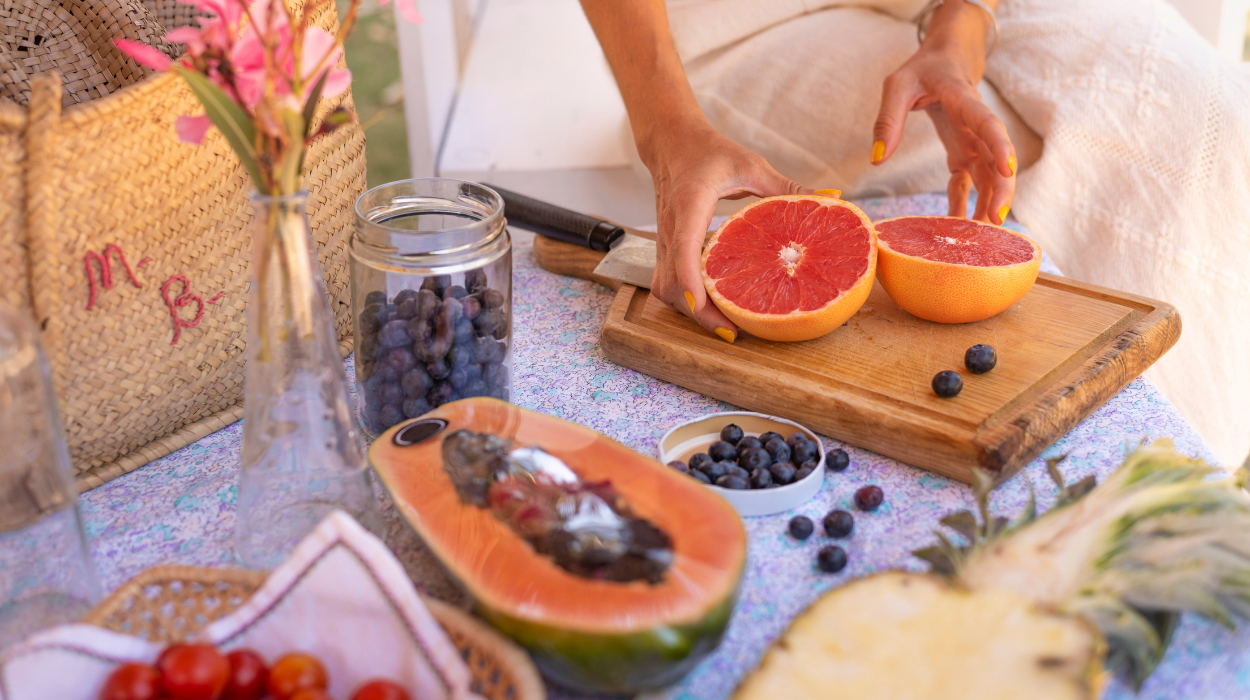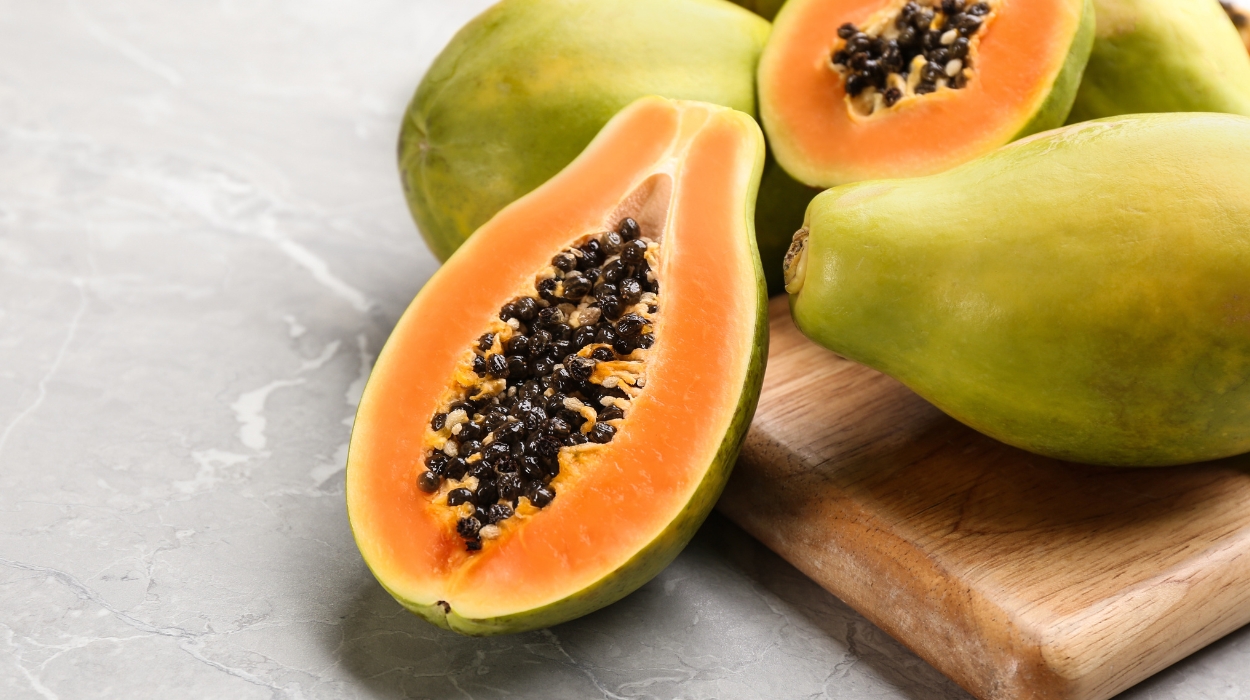Are you looking to shed those extra pounds and want to understand the complexities of weight loss? Starting a weight loss journey can be hard, and finding the right foods can be overwhelming.
Among the many foods linked to weight loss is papaya. While it isn’t a cure-all, its potential health benefits can help your weight loss goals. Let’s uncover the facts together: is papaya good for weight loss?
In this article, we’ll delve into the benefits of papaya and how it might help you lose weight. We’ll also give you some quick and healthy recipe ideas, like refreshing smoothies. This will give you easy and delicious ways to eat papaya for weight loss.
Can Papaya Help You Lose Weight?
Papaya can be a great addition to a weight loss diet due to its low calorie and high fiber content. This will help you feel fuller for longer, potentially curbing excess snacking. It also contains key vitamins and digestive enzymes that support overall health. There are some precautions to be aware of when eating papaya, such as its latex content. Overall, including papaya in a balanced diet along with an active lifestyle may help you lose weight.
Are Papayas Beneficial For Weight Loss?

If you’re exploring weight loss options, considering papayas may put you on the right track. While papaya might not have a direct effect on fat loss, its nutrient-rich composition would be a supportive addition to any weight-loss diet.
Papayas have a good amount of fiber, with around 2.5 grams per cup of diced fruit.[1] Fiber supports weight loss[2] by providing feelings of fullness and reducing the chance of overeating. Dietary fiber also encourages better gut health which has also been closely linked to improved weight loss efforts.
Only around 5% of Americans[3] meet their daily recommended intake of fiber. One study found that people with low fiber intake are more likely to suffer from cardiovascular disease,[4] diabetes, and colorectal cancer.
Papaya fruit also has a high water content and is low in calories, helping create a feeling of fullness to support a calorie deficit. One cup of diced papaya has around 62 calories,[1] making it a great, low-calorie snack. Papayas are naturally sweet, which could help satisfy your cravings for sugary treats with a fraction of the calories.
Including papayas in your diet could be helpful with your weight loss goals. The key to sustainable weight loss is a healthy diet, including plenty of fruit and vegetables in conjunction with an active lifestyle.
If you’re struggling to lose weight, many supplements on the market can help you. Always speak to a healthcare professional before adding supplements to your daily routine as they can sometimes interfere with medications.
Health Benefits Of Papaya For Weight Loss
Papaya has a rich variety of antioxidants, which are great for fighting inflammation[5] — a major factor in many chronic diseases. Papaya’s key antioxidants include vitamin C, which plays a key role in a healthy immune system.[6] Regularly eating papaya could help you to combat bacterial and viral infections more effectively.
Papaya is also rich in the antioxidant beta carotene, which is key for visual and bone health.[7]
Another key antioxidant found in papaya is lycopene. Lycopene has been found to have anti-cancerous properties, with one study finding that higher lycopene intake was directly linked to lower prostate cancer[8] rates.
This tropical fruit also has an enzyme known as papain, which helps the breakdown of dietary proteins[9] and is commonly used to tenderize meat. Though papain is often linked to weight loss benefits[10] in animals, current scientific evidence does not firmly support this in humans just yet.
How To Incorporate Papaya Into Your Diet

There are many ways to add papaya into your diet to help support healthy eating habits. One simple idea is to eat papaya as a standalone snack by slicing it up into cubes or wedges.
You can also blend it into smoothies, combining it with other low-calorie fruits such as berries and plain yogurt for a healthy, low-calorie drink. Here’s one recipe for you to try:
TROPICAL PAPAYA BLISS SMOOTHIE
Ingredients:
- 1 cup diced papaya
- ½ cup mixed berries
- ½ medium banana
- ½ cup Greek yogurt (plain or vanilla)
- ½ cup coconut water or almond milk
- 1 tablespoon chia seeds
- 1 teaspoon honey or agave syrup (optional, added for sweetness)
- Ice cubes (as desired for consistency)
Instructions:
- Place the diced papaya, berries, banana, Greek yogurt, coconut water or almond milk, and chia seeds into a blender.
- Add honey or agave syrup for extra sweetness.
- Blend on high speed until smooth and creamy.
- Add ice cubes if you prefer a thicker or colder consistency and blend again until well-mixed.
- Pour into a glass and enjoy your refreshing smoothie!
Additional Tips:
- Feel free to customize by adding spinach or kale for extra nutrients without altering the flavor.
- Adjust the liquid content to achieve your preferred consistency.
For a light yet filling meal idea, try making a papaya and avocado salad with a drizzle of lime vinaigrette, which offers a healthy mix of flavors and nutrients. This salad is full of healthy fats, fiber, and essential nutrients, providing a delicious and satisfying option for weight loss. Here’s the recipe:
PAPAYA AND AVOCADO SALAD WITH LIME VINAIGRETTE
Ingredients:
- 1 ripe papaya, peeled, seeded, and diced
- 1 ripe avocado, peeled, pitted, and diced
- 1 cup mixed greens (spinach, arugula, or your choice)
- ¼ cup chopped fresh cilantro
- ¼ cup chopped red onion
- 2 tablespoons chopped almonds or pumpkin seeds (optional, for added crunch)
Lime Vinaigrette:
- 2 tablespoons freshly squeezed lime juice
- 1 tablespoon extra-virgin olive oil
- 1 teaspoon honey or agave syrup
- Salt and pepper to taste
Instructions:
- In a large bowl, combine the diced papaya, avocado, mixed greens, chopped cilantro, red onion, and nuts/seeds if using.
- Whisk together the lime juice, olive oil, honey or agave syrup, salt, and pepper to create the vinaigrette.
- Drizzle the lime vinaigrette over the salad and gently toss until all ingredients are evenly coated.
- Serve immediately and enjoy your salad!
Additional Tips:
- Feel free to add grilled chicken, shrimp, or tofu for a protein boost.
- Adjust the sweetness or tanginess of the vinaigrette according to your taste preferences.
Try pairing papaya with a healthy grain, such as quinoa for a quick and filling dinner idea. Here is a recipe for a quinoa bowl:
PAPAYA AND VEGGIE QUINOA BOWL
Instructions:
- 1 cup cooked quinoa
- 1 ripe papaya, diced
- 1 cup steamed broccoli florets
- ½ cup sliced carrots
- ¼ cup chopped fresh cilantro
- 1 tablespoon chopped cashews or peanuts
- Lime wedges for garnish
Sauce:
- 2 tablespoons low-sodium soy sauce
- 1 tablespoon rice vinegar
- 1 teaspoon sesame oil
- 1 teaspoon honey or agave syrup
- 1 teaspoon grated ginger
Instructions:
- In a bowl, combine the cooked quinoa, diced papaya, steamed broccoli, sliced carrots, chopped cilantro, and chopped nuts.
- Mix the ingredients for the sauce in a separate bowl, then drizzle over the quinoa mixture.
- Toss everything together until well combined. Serve with lime wedges for extra zest.
When choosing a papaya, try to plan when and how you want to eat it. Unripe papaya is typically green and lacks the classic flavor and texture associated with ripe papaya. However, unripe papaya can be used in various cooked dishes or specific salads, which may be worth looking into.
Ripe papaya usually has red or orange skin. Try and aim for a slightly soft texture when gently pressing the fruit, avoiding overly soft ones.
If you buy unripe papayas intending to ripen them at home, store them at room temperature until they ripen.
When it’s time to enjoy your papaya, slice it open, remove the seeds, and spoon out the orange flesh. While papaya seeds[11] are not toxic, most people don’t like to eat them.
Precaution To Keep In Mind
While papayas offer several health benefits, a few precautions are worth considering when eating them.
Unripe, raw papayas contain high amounts of latex,[12] which diminishes as the fruit ripens. People with latex allergies may be sensitive to papayas and potentially experience allergic reactions. If you have a latex allergy, make sure you speak to a healthcare professional before adding it to your diet.
While papayas offer significant amounts of fiber, excessive consumption may cause an upset stomach[13] and diarrhea. If you experience these symptoms after eating papaya, consider reducing your intake.
The Bottom Line
While eating papaya won’t directly cause weight loss, its benefits could support achieving a healthy weight.
Papaya fruit is low in calories and an excellent fiber source, which can enhance satiety and support healthy weight loss. It’s also full of antioxidants, which support the immune system and helps inflammation.
When you incorporate papaya into your diet, make sure you consider its precautions before consumption. Papaya’s many benefits make it a great option for a balanced lifestyle, so consider trying it today!
Frequently Asked Questions
Ripe papayas tend to have a higher sugar content,[14] while unripe papayas contain less sugar and may have a tangier taste. Portion control is advised if you’re closely monitoring your sugar intake.
Eating papaya will not directly help lose belly fat. Papaya can support overall weight loss due to its low-calorie and high-fiber content. Losing belly fat requires a balanced diet and regular exercise.
Eating papaya daily can promote weight loss due to its low-calorie, high-fiber content. Moderation and balance are key, and excessive intake may cause stomach upset.
Morning or as a snack can be good for papaya consumption as it can help you feel fuller throughout the day. However, enjoy it at a time that best fits your routine and weight loss diet.
 Expert's opinion
Expert's opinion